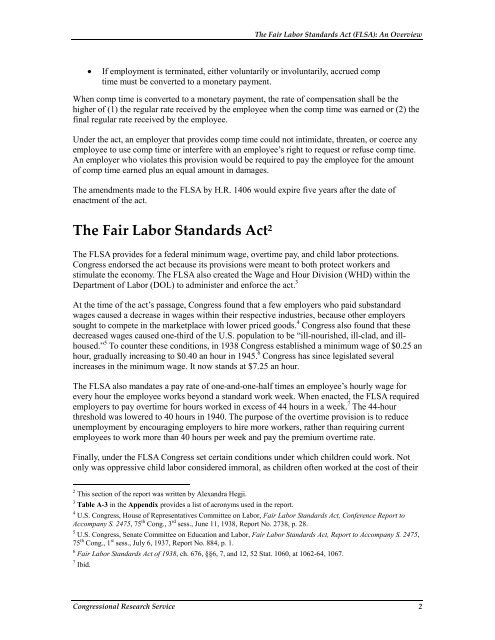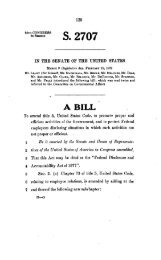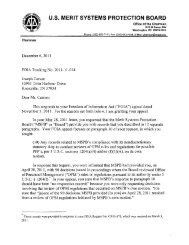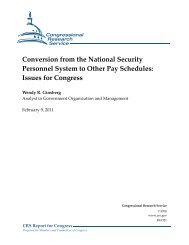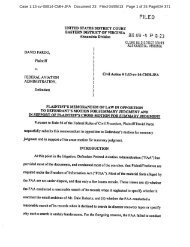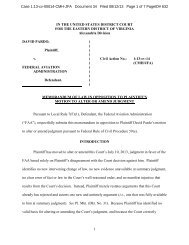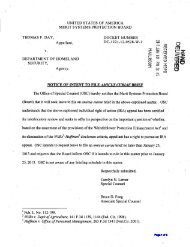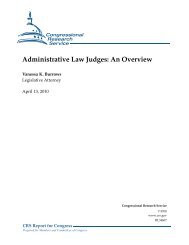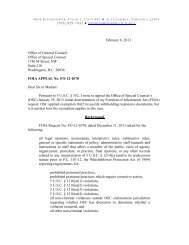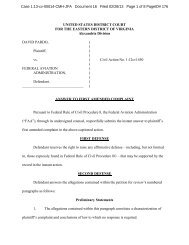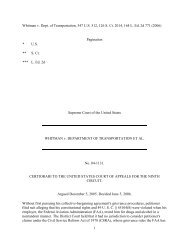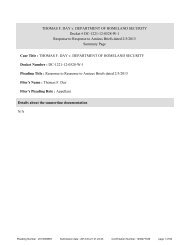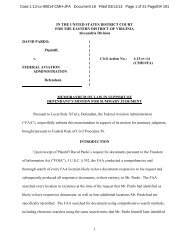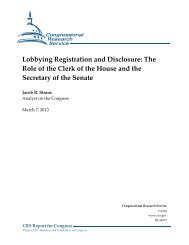The Fair Labor Standards Act (FLSA): An Overview - MSPB Watch
The Fair Labor Standards Act (FLSA): An Overview - MSPB Watch
The Fair Labor Standards Act (FLSA): An Overview - MSPB Watch
You also want an ePaper? Increase the reach of your titles
YUMPU automatically turns print PDFs into web optimized ePapers that Google loves.
<strong>The</strong> <strong>Fair</strong> <strong>Labor</strong> <strong>Standards</strong> <strong>Act</strong> (<strong>FLSA</strong>): <strong>An</strong> <strong>Overview</strong>• If employment is terminated, either voluntarily or involuntarily, accrued comptime must be converted to a monetary payment.When comp time is converted to a monetary payment, the rate of compensation shall be thehigher of (1) the regular rate received by the employee when the comp time was earned or (2) thefinal regular rate received by the employee.Under the act, an employer that provides comp time could not intimidate, threaten, or coerce anyemployee to use comp time or interfere with an employee’s right to request or refuse comp time.<strong>An</strong> employer who violates this provision would be required to pay the employee for the amountof comp time earned plus an equal amount in damages.<strong>The</strong> amendments made to the <strong>FLSA</strong> by H.R. 1406 would expire five years after the date ofenactment of the act.<strong>The</strong> <strong>Fair</strong> <strong>Labor</strong> <strong>Standards</strong> <strong>Act</strong> 2<strong>The</strong> <strong>FLSA</strong> provides for a federal minimum wage, overtime pay, and child labor protections.Congress endorsed the act because its provisions were meant to both protect workers andstimulate the economy. <strong>The</strong> <strong>FLSA</strong> also created the Wage and Hour Division (WHD) within theDepartment of <strong>Labor</strong> (DOL) to administer and enforce the act. 3At the time of the act’s passage, Congress found that a few employers who paid substandardwages caused a decrease in wages within their respective industries, because other employerssought to compete in the marketplace with lower priced goods. 4 Congress also found that thesedecreased wages caused one-third of the U.S. population to be “ill-nourished, ill-clad, and illhoused.”5 To counter these conditions, in 1938 Congress established a minimum wage of $0.25 anhour, gradually increasing to $0.40 an hour in 1945. 6 Congress has since legislated severalincreases in the minimum wage. It now stands at $7.25 an hour.<strong>The</strong> <strong>FLSA</strong> also mandates a pay rate of one-and-one-half times an employee’s hourly wage forevery hour the employee works beyond a standard work week. When enacted, the <strong>FLSA</strong> requiredemployers to pay overtime for hours worked in excess of 44 hours in a week. 7 <strong>The</strong> 44-hourthreshold was lowered to 40 hours in 1940. <strong>The</strong> purpose of the overtime provision is to reduceunemployment by encouraging employers to hire more workers, rather than requiring currentemployees to work more than 40 hours per week and pay the premium overtime rate.Finally, under the <strong>FLSA</strong> Congress set certain conditions under which children could work. Notonly was oppressive child labor considered immoral, as children often worked at the cost of their2 This section of the report was written by Alexandra Hegji.3 Table A-3 in the Appendix provides a list of acronyms used in the report.4 U.S. Congress, House of Representatives Committee on <strong>Labor</strong>, <strong>Fair</strong> <strong>Labor</strong> <strong>Standards</strong> <strong>Act</strong>, Conference Report toAccompany S. 2475, 75 th Cong., 3 rd sess., June 11, 1938, Report No. 2738, p. 28.5 U.S. Congress, Senate Committee on Education and <strong>Labor</strong>, <strong>Fair</strong> <strong>Labor</strong> <strong>Standards</strong> <strong>Act</strong>, Report to Accompany S. 2475,75 th Cong., 1 st sess., July 6, 1937, Report No. 884, p. 1.6 <strong>Fair</strong> <strong>Labor</strong> <strong>Standards</strong> <strong>Act</strong> of 1938, ch. 676, §§6, 7, and 12, 52 Stat. 1060, at 1062-64, 1067.7 Ibid.Congressional Research Service 2


